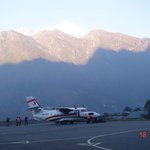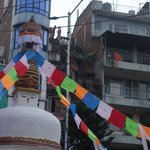Highlights
- Follow the stone steps leading up through beautiful Sherpa villages
- Catch a glimpse of Mt. Everest, and the picturesque peak of Ama Dablam
- Explore great day hikes from Namche, a village perched high in the Himalaya
- Visit Tengboche, home to one of the regions most famous monasteries
- Want to splurge? Tour the Everest region by helicopter, an unforgettable experience
Planning Your Trek
For all the routes listed below, your trek will start with a flight from Kathmandu to Lukla, the gateway village of the Everest region. Most treks in the Everest region start with a flight, and this will help maximize your time higher up in the valley.
From Lukla, the five-day trek takes you to Namche Bazaar, the bustling heartland of Sherpa culture. With Namche as your base, you can take a day hike to the beautiful village of Thame, with a picturesque monastery perched high up on the cliffs. Thame is off the main Everest Base Camp route and therefore receives few visitors. The house of Sherpa Tenzing Norgay (the legendary Sherpa who accompanied Sir Edmund Hillary on the first successful ascent of Everest in 1953) is located in Thame.
If you add on two more days (for a total of seven days), you can continue on as far as Tengboche. Here, you can visit the famous monastery where climbers and trekkers traditionally visit the Head Lama to receive his blessings for a successful trip. Tengboche also offers extraordinary close-up views of Ama Dablam, a deserving candidate for the world’s most beautiful mountain.
If you have ten days, consider completing the Kongde Loop. This includes a stop in Namche Bazaar, Thame, and Kongde, at the foot of Kongde Ri (peak). Getting up early to watch the sun rise over Kongde Ri is one of the many highlights of this route.
If you’re in a situation where time is limited and money isn’t an issue, consider adding a helicopter ride into one of these itineraries. Not only will this shorten the trip significantly, but you’ll have unforgettable views that can’t be had any other way.
#1 Namche Bazaar & Thame - 5 Days

| Day | Destination | Altitude | Duration |
|---|---|---|---|
| Day 1 | Phakding | 2610m | 4 hrs |
| Day 2 | Namche Bazaar | 3440m | 6-7 hours |
| Day 3 | Namche Bazaar (day hike to Thame, 3800m) | 3440m | Day Hike |
| Day 4 | Lukla | 2860m | 7 hrs |
| Day 5 | Kathmandu | 1400m | 30 min |
#2 Tengboche Monastery - 7 Days

| Day | Destination | Altitude | Duration |
|---|---|---|---|
| Day 1 | Phakding | 2610m | 4 hrs |
| Day 2 | Namche Bazaar | 3440m | 6-7 hours |
| Day 3 | Namche Bazaar (day hike to Thame, 3800m) | 3440m | Day hike |
| Day 4 | Tengboche | 3800m | 6 hrs |
| Day 5 | Namche Bazaar | 3440m | 5 hrs |
| Day 6 | Lukla | 2860m | 7 hrs |
| Day 7 | Kathmandu | 1400m | 30 min |
#3 The Kongde Loop - 10 Days

| Day | Destination | Altitude | Duration |
|---|---|---|---|
| Day 1 | Phakding | 2610m | 4 hrs |
| Day 2 | Monjo | 2835m | 3 hrs |
| Day 3 | Namche Bazaar | 3440m | 6 hrs |
| Day 4 | Namche Bazaar | 3440m | Day Hikes |
| Day 5 | Thame | 3800m | 3 hrs |
| Day 6 | Kongde | 4250m | 7 hrs |
| Day 7 | Kongde | 4250m | Free to exploration Kongde area |
| Day 8 | Phakding | 2610m | 5 hrs |
| Day 9 | Lukla | 2860m | 4 hrs |
| Day 10 | Kathmandu (flight) | 1400m | 30 mins |
Please note: The walk from Thame to Khongde can only be done at certain times of year when conditions are good, or by people with rope skills and with the right equipment. At the wrong time of year with inexperienced people, it would be very dangerous. It is one of the most amazing walks if the not the best in all of Khumbu, but it is dangerous! Consult your trekking expert and guide before going on this trek.
Chat with a local specialist who can help organize your trip.
#4 Pikey Peak Trek

Pikey Peak is a peak and ridgeline that cuts across the lower Everest Region, southwest of Lukla. It's a great choice for those looking to experience rural Nepal and offers great views of Everest. From Kathmandu, you can either drive or fly in to access the trek, and the routes are customizable — from three to seven days depending on how much time you have. We recommend doing Pikey Peak in seven days.
Everest by Helicopter
If you’re interested in hiring a helicopter, then touring the Everest region by helicopter is one of the most memorable experiences you can have in Nepal — or the world.
You can combine trekking with a helicopter pick-up. There are various places in the region suitable for helicopter pick-ups, with Namche Bazaar/Syangboche and Lukla the most common.
Best Season
As with most other treks in Nepal, the best times to do it are spring (March-May) and fall (September-November). During these months the weather is likely to be clear, and daytime temperatures warm. The Khumbu region, however, is known to be particularly cold and dry, and many trekkers develop the ‘Khumbu cough’ due to the dry dust.
It is usually possible to trek in the summer/monsoon and winter seasons, but greater preparation for difficult conditions is required. You may not get clear views during the monsoon.
Getting there & away
All treks in the Khumbu region require a flight from Kathmandu to the small airport at Lukla (unless you are taking the longer, overland route via Jiri). The flight is a stunning experience in itself. Numerous flights are made daily from Kathmandu in small fixed-wing airplanes, taking around 30 minutes. However, bad weather frequently closes the airport, so it’s wise to prepare for delays if flying to Lukla and to keep a day or two as buffer days.
Permits & regulations
The Sagarmatha National Park (through which you'll be trekking) is a UNESCO World Heritage site. As with all treks in this park, you’ll needs a TIMS card (US$10) and a Sagarmatha National Park permit (US$30).
If you’re trekking with an agency, they will arrange these for you. If you’re arranging the trek yourself, you’ll need to pick up your TIMS permit in Kathmandu and your Sagarmatha National Park permit in Monjo.
What to bring
As with other treks in Nepal, it is essential to have sturdy hiking boots, a waterproof outer layer and other clothing that can be layered and put on/off as the weather requires. Lodges will be equipped with blankets for cold weather.
Difficulty
The itineraries listed here mostly stay below 4000 m, although altitude-related problems can arise after ascending above 2500 m.
The most challenging day on the shorter itineraries suggested here is the 6-7 hour trek between Phakding and Namche Bazaar. The trail is mostly uphill the whole way. However, you will catch your first glimpse of Everest this day and cross the highest suspension bridge in Nepal, so it will be a memorable day!
If taking a helicopter ride to/near Everest Base Camp, you will reach very high altitudes of above 5000 m. You may experience an increased shortage of breath. However, you won’t be staying at these heights for very long.
Accommodation & meals
Lodges in the Khumbu region are well-developed and relatively comfortable. There is a lot of variety, from ultra-budget to hotels of a quality that you could find in Nepal’s cities, with hot showers and electric blankets on the beds. However, not all grades of accommodation may be available in all settlements, particularly the smaller ones.
The food will also be good, with items such as rice and curry, noodles, momos, soup and Tibetan-style bread featuring on menus. A staple food in the Khumbu region are potatoes, and these feature more prominently on the menus of trekking lodges here than elsewhere in Nepal, with fewer other fresh vegetables. The amount of fresh food available will decline as you progress higher, and costs also rise.
Costs
Trekking in the Everest region is relatively costly because of the necessary airfare between Lukla and Kathmandu. (Adding a helicopter ride into these itineraries would significantly increase the cost, but is great way to get up close to the mountains if you can afford it.) Otherwise, both budget and more luxurious accommodation and food options are available.






